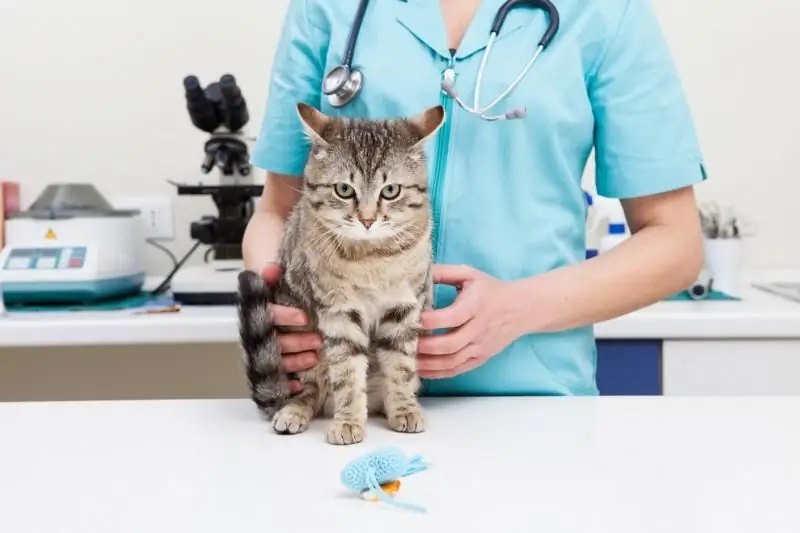
Table of contents:
- Author Bailey Albertson [email protected].
- Public 2023-12-17 12:53.
- Last modified 2025-06-01 07:32.
A doctor is urgently needed: cat has blood in urine
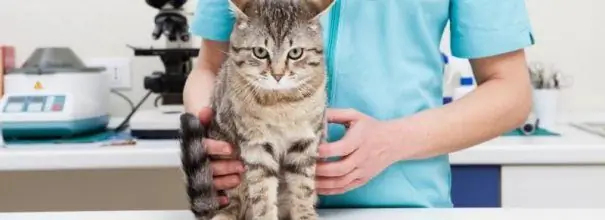
The attention of the owner of the cat may be attracted by a change in the color of its urine due to the admixture of blood. Blood in the urine of a cat is not an alarm bell that the cat's health is not all right, it is an alarm calling for an immediate veterinarian examination and a comprehensive examination in order to establish the cause of hematuria. Hematuria is dangerous both by blood loss itself and by impaired renal function with the possible subsequent development of chronic renal failure, since the kidney tissue is unable to regenerate.
Content
-
1 How blood impurities change the appearance of urine
1.1 Risk group
- 2 Conditions in which hematuria occurs
-
3 When you need to urgently contact the veterinarian
- 3.1 Video: urolithiasis in cats
-
3.2 What diagnostic methods are used by specialists
3.2.1 Video: Diagnostic cystoscopy for hematuria in a cat
- 3.3 How to properly collect urine
- 4 Hematuria in pregnant cats and kittens
- 5 Prevention of hematuria in cats
- 6 Veterinarian recommendations
How blood impurities change the appearance of urine
Hematuria is a condition when there is an admixture of blood in the urine, which appears due to a violation of the integrity of the vessel communicating with the urinary tract. Thus, hematuria is a symptom of both independent diseases of the urinary system and general diseases.
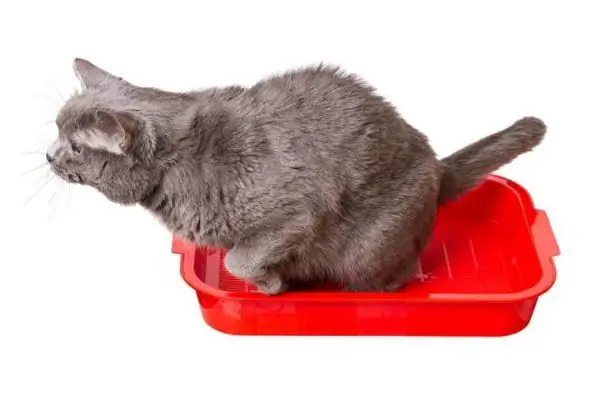
With hematuria, an admixture of blood appears in the urine
Normally, the color of a cat's urine is from pale yellow to almost orange, without a pungent odor. The color of urine is very sensitive to an admixture of blood, and one drop of blood is enough to change the color of 150 ml of urine.
There are two types of hematuria:
- macrohematuria, when an admixture of blood is visible to the naked eye;
-
microhematuria - when an increased content of erythrocytes is determined only by microscopy.

Macro- and microhematuria With gross hematuria, blood is visible to the naked eye
Blood in the urine can look different:
- blood can uniformly stain urine, giving it shades of pink or red;
- the presence of inclusions and various forms of clots against the background of visually normal or altered urine color; the shape of the clots has a diagnostic value: for example, worm-shaped clots are formed in the ureters, shapeless - in the bladder;
- urine can take on a brownish color with prolonged presence of erythrocytes in it; this color of urine usually signals that the bleeding has stopped.
According to the source of bleeding, hematuria is divided into:
- parenchymal renal hematuria, with the localization of the source of bleeding in the renal tissue, for example, with glomerulonephritis, polycystic kidney disease;
- bleeding from the urinary tract, with the localization of the source of bleeding in the ureter, bladder, urethra;
- bleeding in a systemic disease, when the urinary system is involved secondarily, for example, in the pathology of the blood coagulation system.
If the cat does not use the tray, but goes outside, then the appearance of hematuria is very difficult to notice in her; sometimes a change in the color of the coat is noticeable due to traces of blood in the genital area.
And also the color of urine can change:
- the content of plant pigments of anthocyanins in cat food, for example, when eating beets;
- taking certain medications, for example, sulfonamides, phenolphthalein;
- bilirubinuria - urine takes on the color of dark beer, usually combined with manifestations of jaundice, the condition is caused by an increase in the pigment of bilirubin in the blood, for example, in violation of the outflow of bile;
- hemoglobinuria - urine takes on a rich brown color, it is found in infectious diseases, for example, leptospirosis, poisoning with hemolytic poisons; these conditions are also accompanied by jaundice and is caused by massive destruction of red blood cells;
- myoglobinuria - urine becomes almost black, is observed after extensive muscle injury, for example, with prolonged compression syndrome or electrical injury; At the same time, miglobin, a muscle protein, enters the urine.
Also, hematuria is divided into:
- initial - an admixture of blood in the urine appears at the very beginning of urination and signals the localization of the source of bleeding in the urethra;
- terminal - the final portion of urine is stained with blood, usually due to contraction of the bladder muscle - detrusor - at the end of urination, and indicates the location of the source of blood loss in the bladder neck, as well as the prostate gland in cats;
- total - urine in all portions has a uniform changed color, such a change in the color of urine is characteristic of damage to the kidneys, as well as their pelvis, ureters and bladder.
Risk group
Given the fact that most cases of hematuria are due to urolithiasis and cystitis, at risk are:
- obese animals;
- castrated cats and unsterilized cats;
-
long-haired breeds;

Fluffy cat lies on a basket Long-haired cats are at risk of developing diseases of the urinary system.
- animals with an unbalanced diet (excess protein while limiting carbohydrates), vitamin A deficiency, limiting drinking water;
- cats are affected more often than cats;
- middle-aged and elderly animals (over 5 years old), as well as kittens at risk for cystitis.
Conditions in which hematuria occurs
Hematuria develops in a number of diseases:
-
inflammatory diseases of the urinary system:
- pyelonephritis (inflammation of the renal pelvis);
- cystitis - inflammation of the mucous membrane of the bladder;
-
urethritis - inflammation of the urethra (urethra); in addition to hematuria, in inflammatory diseases, they note:
- pain syndrome (with pain, the cat hunches back);
- painful and frequent urination;
- fever;
- decreased activity and appetite in a cat;
-
immune-inflammatory diseases: glomerulonephritis, damage to the nephrons by antigen-antibody complexes occurs, this is accompanied by:
- deterioration in general well-being;
- losing weight;
- periodic fever;
- a decrease in the amount of urine discharge in the acute phase of glomerulonephritis;
- swelling;
- cardiac disorders in the development of hypertension;
- the development of anemia; in urine, in addition to erythrocytes, a high protein content is noted, as well as renal epithelial cells;
- urolithiasis - the formation of calculi (stones) in the renal pelvis and bladder due to metabolic disorders; manifests itself as renal colic in the form of severe pain and anxiety in a cat, frequent, difficult and painful urination with an admixture of dark blood, and can also be manifested by the formation of acute urinary retention, when calculus blocks the lumen of the urethra; it is an urgent urological condition requiring immediate medical attention;
- tumors of the organs of the urinary system, as well as when they are involved in systemic tumor processes, for example, with lymphosarcoma - very often hematuria is the only manifestation of tumor lesions of the kidneys;
- traumatic injury (blunt injury, fall from a height, car injury) - trauma to the organs of the urinary system is suspected in case of injury to the lumbar and pelvic regions, therefore, kidney damage and rupture of the bladder should always be excluded;
- malformations of the organs of the urinary system, as well as their vessels, for example, polycystic kidney disease, while the renal tissue is replaced by hollow fluid formations - cysts; polycystic disease is accompanied by inflammation; the development of the process can be slowed down, but not stopped - the disease is hereditary, the Persian cat is predisposed;
- taking corticosteroids, non-steroidal anti-inflammatory drugs, cytostatics;
- after surgical interventions on the organs of the reproductive system (castration, sterilization), as well as after catheterization of the bladder;
- diseases of the blood coagulation system and poisoning with anticoagulants - while there are other sources of bleeding that are outside the urinary system: stomach, intestinal, nasal, gum bleeding, multiple hematomas;
- blood supply disorders - kidney infarction.
The list of diseases that are manifested by hematuria is extensive. For the correct diagnosis and prescription of therapy, medical assistance is required, as well as the possibility of conducting additional studies. Self-diagnosis and self-medication will not lead to success and worsen the prognosis of the disease. Before visiting the clinic, to alleviate the condition of the pet, you need:
- give the cat complete rest;
-
place the cat in a warm room on a litter, exclude drafts;

Cat in bed To alleviate the condition of the cat, you need to provide her with warmth and peace.
- feed only liquid, easily digestible food, do not give solid foods;
- provide plenty of water for drinking;
- watering decoctions of juniper fruits, horsetail herbs, bearberry, parsley root;
- make an intramuscular injection of No-shpa 1-2 mg per kg of the cat's weight.
Baralgin is often recommended to relieve pain in a cat, but at the stage of first aid, when the diagnosis is still unclear, it is not worth using it. In addition, due to belonging to the group of non-steroidal anti-inflammatory drugs, Baralgin can contribute to the continuation of hematuria. The exact dose of Baralgin, as well as the need for its use, will be determined only by a doctor. The best help for the animal will be immediate delivery to the clinic.
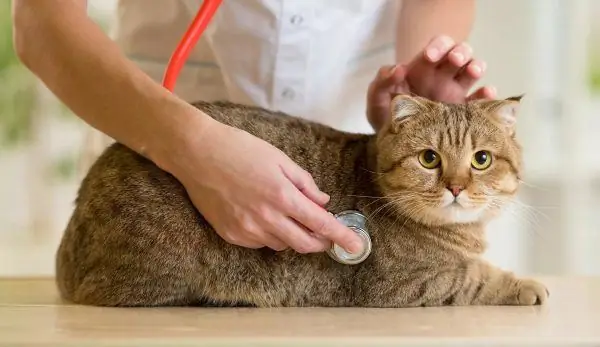
The best first aid for a cat with hematuria will be its immediate delivery to the clinic.
When you urgently need to contact the veterinarian
A veterinarian should be consulted in all cases of blood in the urine of a cat
Reasons for contacting a veterinarian for emergency indications:
- combination of hematuria with manifestations of acute blood loss: pallor of the mucous membranes of the cat, general depression, weakness, frequent and shallow breathing, increased heart rate;
- acute urinary retention, which has arisen against the background of previous hematuria, can be caused by tamponade of the bladder with blood clots or blockage of the urethral lumen with urinary calculus;
- combination of hematuria with fever;
- suspected anticoagulant poisoning;
- in the presence of severe pain syndrome;
- with injuries.
Video: urolithiasis in cats
What diagnostic methods are used by specialists
The doctor asks the owner about the onset and manifestations of the disease in the cat, specifies the conditions for its feeding and maintenance; then examines the cat. To clarify the diagnosis, modern veterinary medicine has a whole arsenal of additional diagnostic methods:
- a general blood test - the severity of anemia, as well as inflammatory changes, is assessed;
- general urine analysis - the degree of hematuria, the presence of protein and leukocytes in the urine are assessed; the presence of other components (mucus, bacteria, salt crystals);
- biochemical blood test - collection of information about the functional state of internal organs, kidney function is assessed by the content of urea and creatinine;
- bacteriological culture of urine to determine the sensitivity of flora to antibiotic therapy in the inflammatory nature of the disease;
- coagulogram - if you suspect a blood clotting disorder;
- Ultrasound of the abdominal cavity and retroperitoneal space - allows you to assess the change in the shape, structure and location of the kidneys and urinary tract, the use of Doppler - to examine the vessels of the kidneys and blood flow in them;
- endoscopic examination, carried out under anesthesia, the mucous membrane of the bladder and the mouth of the ureters is examined with an endoscope;
- computed tomography - can be performed to clarify the diagnosis in some cases;
- radiographic methods - now they are used less often, since the ultrasound method is safer and more informative; X-ray is used for trauma, suspected stones (but not all stones are visualized in this way); expands the information content of the method using contrast.
Video: diagnostic cystoscopy for hematuria in a cat
How to properly collect urine
The cat's morning urine is collected and must be delivered to the laboratory in the next 3-4 hours:
- Remove the litter from the cat's tray, wash the tray itself thoroughly.
- After the cat visits the litter box, the urine is transferred from it to a plastic container with a lid, which can be purchased at a regular or veterinary pharmacy.
- It is convenient to use a disposable syringe to collect urine from the tray.
It is also possible to collect urine for analysis using bladder catheterization - in a veterinary clinic.
Hematuria in pregnant cats and kittens
In pregnant cats, traces of blood in the urine often appear from the genital tract and indicate the onset of labor; bloody discharge from the genital tract after childbirth can be observed for another 1-2 weeks. In all other cases, a pregnant cat must be immediately examined by a veterinarian.
Blood in the urine of a kitten usually indicates an inflammatory disease of the urinary system, as well as possible malformations of its development. Therefore, given the low compensatory reserves of kittens, it is also worth rushing to see a doctor.
Prevention of hematuria in cats
To prevent hematuria in cats, you need to:
- avoid hypothermia of the cat;
- monitor adequate water intake;
- to ensure proper nutrition of the cat, especially to exclude low-quality industrial feed;
- conduct regular examinations of the veterinarian;
- provide periodic laboratory monitoring of blood and urine parameters, especially in cats over 5 years old;
- prevent the cat from eating toxic substances;
- timely treat foci of chronic infection, especially gingivitis, which are often ignored;
- timely suppress allergic reactions;
- conduct timely vaccination and deworming.
Veterinarian recommendations
Hematuria is a formidable symptom of both diseases of the urinary system and general diseases with secondary involvement of the kidneys and urinary tract. Diseases that cause hematuria are dangerous in themselves, since they can cause the formation of chronic renal failure and are accompanied by blood loss. Self-diagnosis and treatment of hematuria is unacceptable and will result in a loss of time, a worsening of the cat's condition and an aggravation of the prognosis of the disease. Veterinarians strongly recommend not to postpone the visit to the clinic in case of symptoms of hematuria in a cat.
Recommended:
Dry And Hot Nose In A Cat Or Cat: Causes (a Symptom Of What Diseases And Conditions May Be) Phenomena In Kittens And Adult Animals
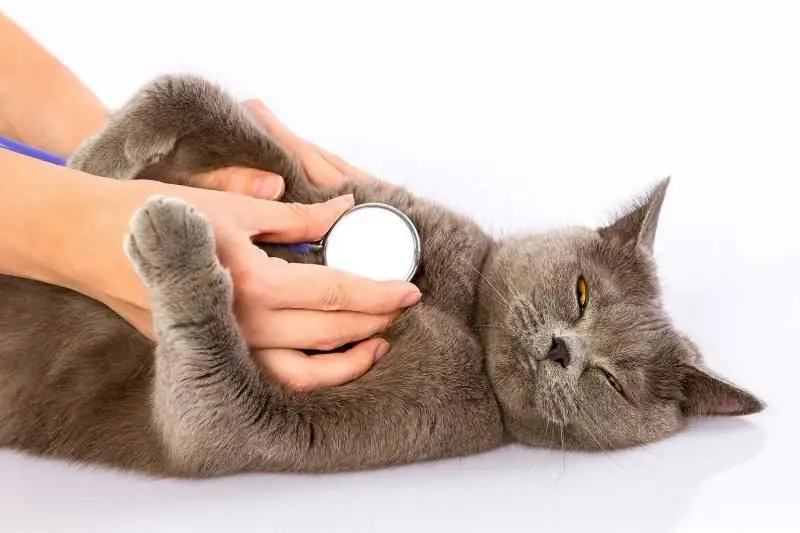
In what situations a warm and dry nose in a cat is normal, and when in case of illness. How to understand that a cat is sick. When a doctor is urgently needed. Recommendations
A Cat Or A Cat Vomits With White Foam: The Reasons For Such Vomiting In Kittens And Adult Animals, Diagnosis And Treatment, Recommendations Of Veterinarians

Vomiting of white foam in cats, what can be caused. Additional examination methods for diagnosis. First aid, treatment. Preparations for the prevention of vomiting
Cat's Or Cat's Eyes Fester: Reasons For What To Do And How To Treat A Kitten And An Adult Animal At Home, How To Wash It Out Of Pus

What does purulent discharge from the eyes look like in cats? For what diseases does the symptom occur? How is it treated. Care recommendations. Preventive measures
How To Wean A Cat And A Cat To Tear Wallpaper And Furniture, Features Of Weaning Kittens And Adult Animals, Useful Tips And Tricks, Reviews
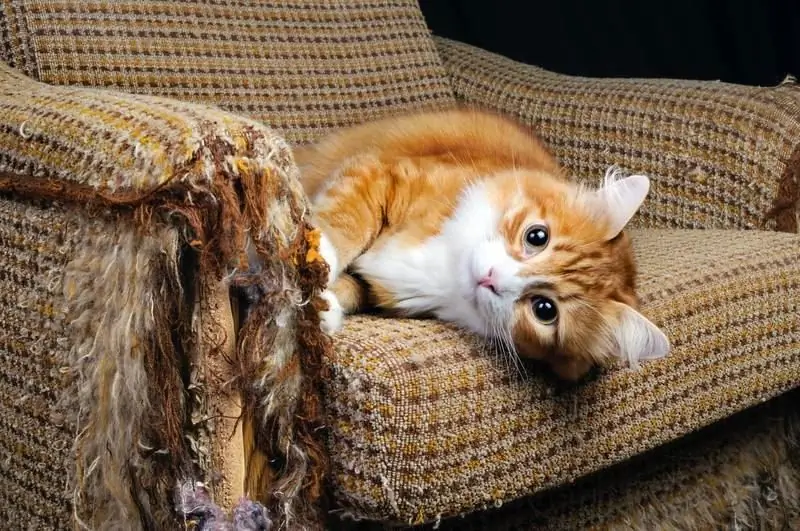
Why does a cat tear wallpaper and furniture? How to prevent damage to property. What to do if you can't wean your cat
Why Does A Cat Or Cat Meow Constantly, The Reasons For This Behavior In Adult Animals And Kittens, What To Do If They Walk Around The House And Yell At Night

The reasons why a cat or kitten meows constantly. How to deal with it. When do you need to urgently see a doctor?
